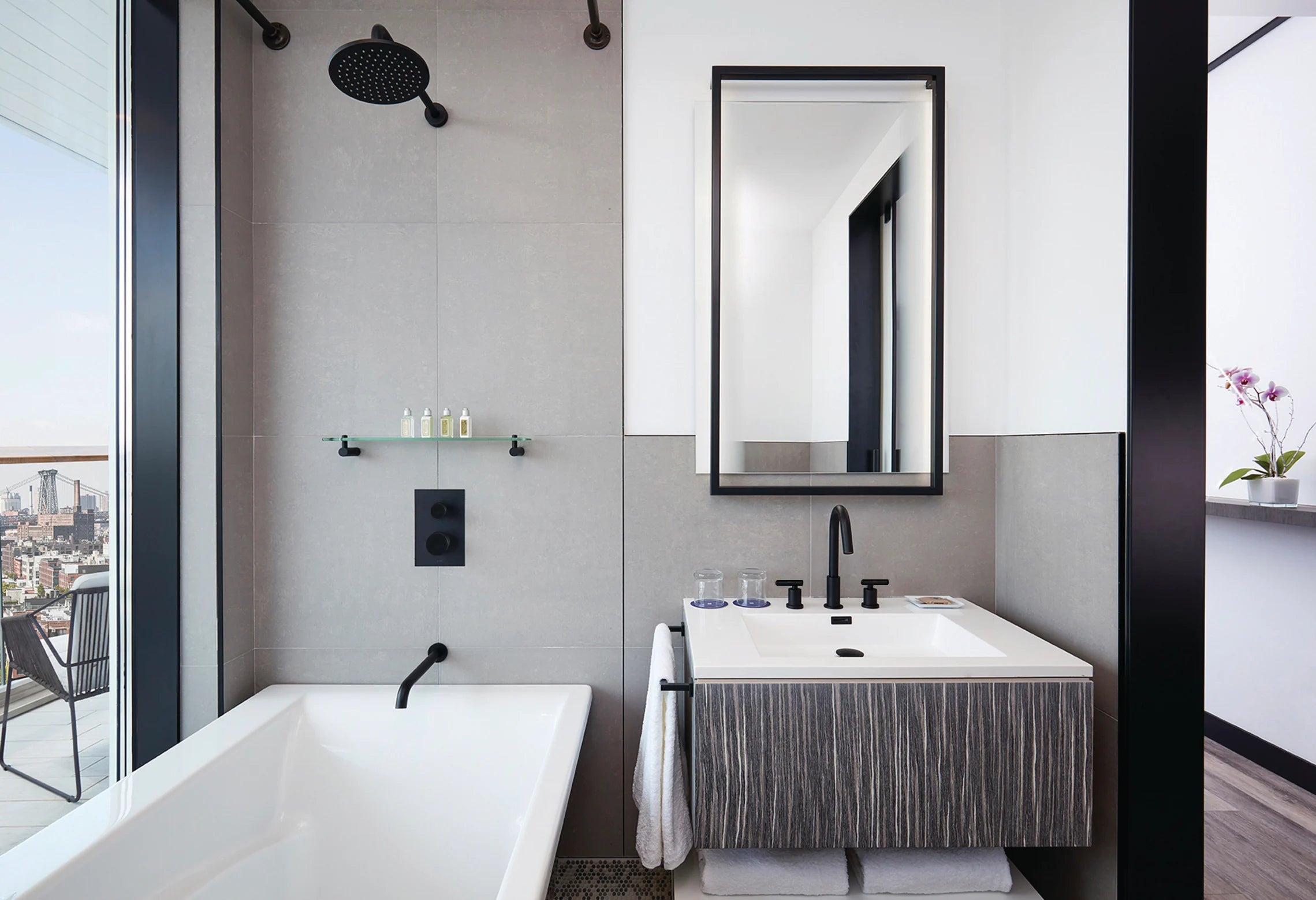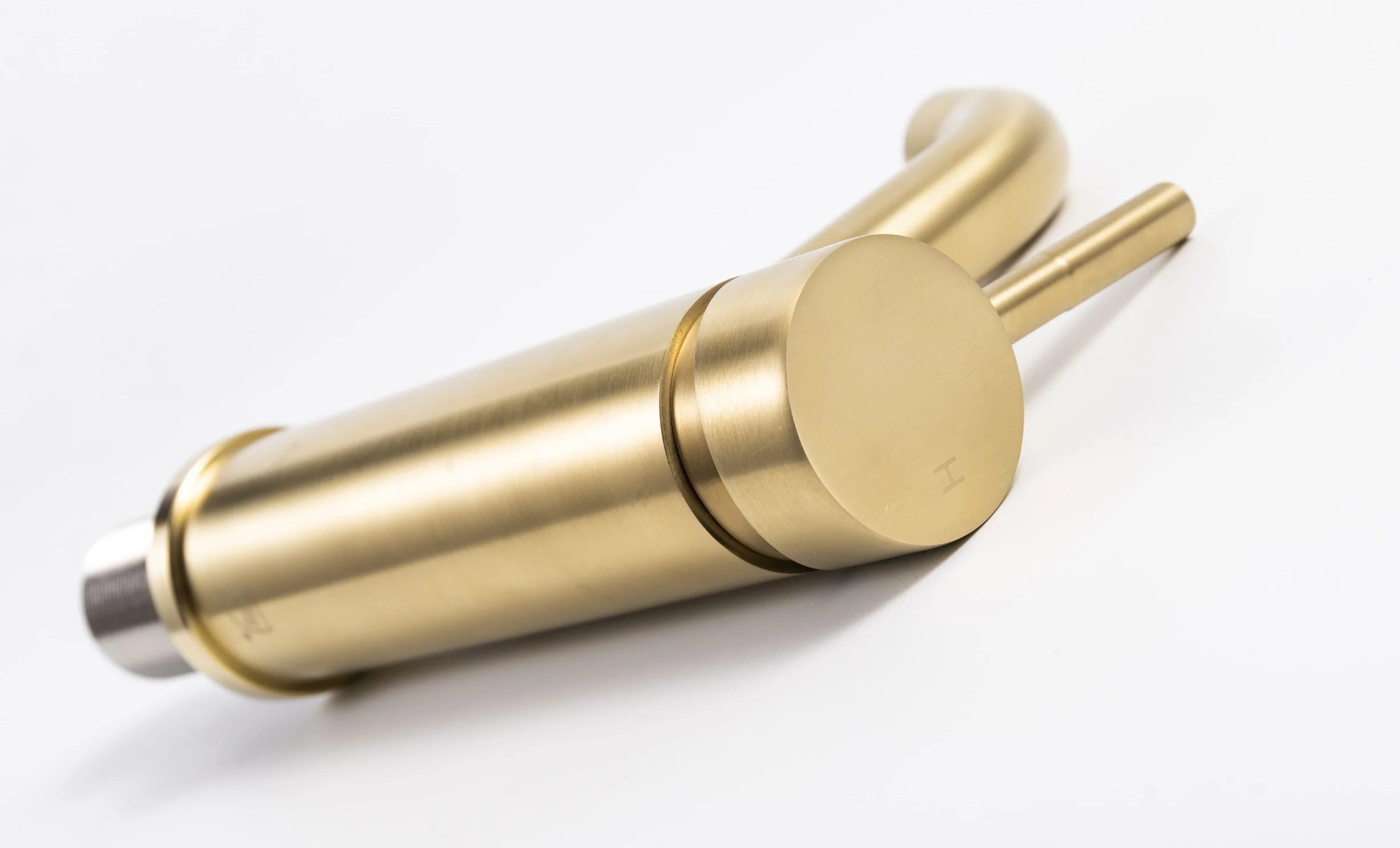How to choose a bathroom faucet: The ultimate guide
Bathroom faucets are a really important part of overall bathroom design. But because they’re a relatively small item in the overall design scheme, people often don’t put a lot of thought into what they want or need in a faucet ahead of time.
They then arrive at the showroom expecting to make a quick choice, only to discover more options than they ever thought existed, leading to confusion and overwhelm that can actually hold up progress on their bathroom project.
Choosing the right bathroom faucet is about much more than just aesthetics. There are lots of different features to consider – and in this guide, we’ll help you understand all the options, and choose a faucet that works for your (or your client’s) home, budget and lifestyle.

Why are faucets important?
Choosing the right bathroom faucets is important primarily from a practical level. It’s vital that the faucets you choose are practical, working in harmony with other elements in the room and also meeting your physical needs.
For example, if you have a large tub, you need a faucet with a high flow rate or you’ll struggle to fill it with hot water, while households with elderly, disabled or very young residents may need faucets with easy-to-use lever controls.
As well as their practical function, however, faucets have an important aesthetic role to play. Faucets do for bathrooms what jewellery does for a great outfit - they are the accessories that can pull the whole scheme together, which means that the style and finish you select can have a big impact on the overall look.

What are the different types of bathroom faucets?
There are a range of different types of bathroom faucets designed for different functions, as well as a number of variations of each type. Here’s a quick guide to some of the options:
Lavatory faucets
A lavatory faucet is just another name for the faucet that goes on your wash basin. The term ‘lavatory’ is used to distinguish these from kitchen faucets and tub fillers. Lavatory faucets come in various styles:
Single hole faucets
A single hole faucet is designed to fit a single hole basin – that is, it has one hole cut in the sink or countertop. A single hole faucet is a mixer faucet, where the hot and cold water come from the same water outlet. Single hole faucets usually have one handle, lever or knob to control the water temperature and flow. They can be offset to one side of the basin (useful for smaller hand basins), or positioned in the center.
Widespread faucet
Widespread faucets have a more traditional-looking arrangement of components with a central faucet spout, and two separate controls located either side. They are still mixer taps, allowing you to easily control the volume and temperature of the water.
Center-set faucets
A center-set faucet is a mixer faucet with a single spout and two controls, all mounted together on a single, wide base. Center-set faucets are installed on a basin with two holes for separate cold and hot water inlets, but they function in much the same way as a single hole faucet. This style is somewhat dated these days, but still widely available and usually very cheap.
Wall mounted vs deck mounted faucets
Lavatory faucets can be deck mounted or wall mounted. Deck mounted means they sit on the side of the basin itself, or sometimes on the surface of a vanity unit if a freestanding bowl-type basin is installed.
Wall mounted faucets, as the name suggests, are mounted on the wall, often in a widespread configuration. This option is popular when space is limited, or when the basin design doesn’t allow for a deck-mounted faucet. Wall mounted faucets offer superior hygiene, but they can be difficult to repair or replace if something goes wrong, since the fittings are concealed behind the wall.

Tub fillers
Tub fillers are faucets specifically designed for use with a bathtub. They typically have an unrestricted flow rate that allows a lot of water to flow into the tub quickly. This is important for efficient energy use, and also for user comfort and convenience.
As with lavatory faucets, tub fillers come in different styles including deck-mounted, wall mounted and freestanding. The faucet you choose will depend on the type and size of your tub, the amount of available space, and the overall aesthetic you want to achieve. See our guide to the different types of tub fillers.
Bidet sets
A bidet set is a crossover between a lavatory faucet and a shower set. It’s usually wall mounted, with a handheld sprayer and a wall bracket like a shower – but instead of a rain head sprayer, a bidet set has a faucet outlet with trigger controls.
A bidet faucet can be used like a conventional faucet to fill the bidet, or detached for personal care. Interestingly, we’re seeing more and more of our bidet sets being installed into wet rooms and garages, where they are being used as dog wash stations.

How can you tell if a faucet is good quality?
It can be difficult to know if a faucet is good quality based on appearance, or even on price. Some cheaply-made faucets are expensive because they’ve got a well-known brand name behind them.
Asking the right questions can help you identify whether a faucet is good quality or not. First of all, check what the faucet is made of. High-quality plumbing fixtures like faucets and shower sets will always be made from brass or stainless steel, rather than lighter metals like zinc, which can warp or break over time. Your faucet should feel reassuringly heavy in the hand – this is a good indication of solid construction.
Next, check the finish. Most faucets have an electroplated metal finish, while very premium brands sometimes use a process called Physical Vapor Deposition (PVD) to create a very thin and extremely durable coating of the desired metal finish on their hardware.
With electroplating, it’s important that the coating isn’t too thin – this can cause the finish to bubble, peel and fall off over time. You can’t tell by looking at an electroplated faucet how thick the coating is, so look for a warranty or guarantee on the finish. Anything less than 5 years may denote inferior quality.
Tarnish-prone finishes like bronze may be finished with an epoxy coating to reduce maintenance, but you should be aware that these coatings are not as durable as metal, and may wear off over time. Find out more about how to spot a quality faucet.

Which finish of faucet should I choose?
The finish or color of your faucet is largely down to personal taste and the overall décor of your bathroom. For many years now, white metals like chrome have been the most popular, but we’re currently seeing a trend of more color in the washroom, with rich tones of gold and satin brass, or contemporary matte black. The majority of metal finishes come in polished or brushed options.
Chrome and steel
White metals like chrome and stainless steel have a ‘cold’ appearance. They are a great choice for very contemporary bathroom spaces and rooms with limited natural light. They can also be the best choice if your overall scheme is very bold, because they can blend with any other color and tend to recede into the background, allowing other features to shine.
Nickel
Nickel is a white metal with golden undertones, which makes it a great compromise when you want to add a little more character with your faucets, but you don’t want to introduce a stronger color. Nickel has a natural warmth that can make your bathroom feel more inviting, making it ideal for dark or north-facing rooms.
Gold and brass
Warm-toned metals like gold and brass are firmly back in fashion, lending effortless glamor and richness to the bathroom. Brass in particular is growing in popularity, and lends some much-needed softness to bathroom spaces that might otherwise feel quite stark.
Should I choose a polished or brushed finish for my faucet?
Again, this is largely a matter of personal taste. A polished finish reflects more light but also shows up blemishes and water spots more easily. A brushed or satin finish is easier to maintain, but tends to have a more muted appearance. This may be desirable – for instance, satin brass has a softer, less brash appearance than its traditional, polished counterpart.
What features should I look for in a faucet?
There are a number of features you may want to consider when choosing a new faucet for your bathroom. These include practical, lifestyle and environmental considerations.
Water efficiency
If you live in an area like California, where there are tight restrictions on water consumption, you’ll want to make sure your faucet complies with the regulations without compromising on performance. Before purchasing, make sure your faucet is supplied with the right valves and flow restrictors – your plumber can help, or ask our expert team. Look for a high-quality flow aerator that makes a little water feel like a lot!
Sensor faucets
Touchless or sensor faucets are often associated with public toilets, but more and more people are installing them in domestic homes too. Sensor faucets are an ideal choice for powder rooms and can enhance water efficiency because they reduce the risk of a faucet being left running. They’re also great for kids and the elderly, being super easy to use and completely safe, with no risk of scalds.
We’re the faucet experts!
At Artos, we have more than two decades of experience in the design of high quality faucets and other plumbing fixtures. We’re inspired by Italian design, and our products are made in Europe using solid brass construction and quality metal finishes. Our faucets come with a lifetime warranty.
To find out more about our collections, visit your nearest Artos dealer – or if you’re in the trade, get in touch to join our dealer network today!
